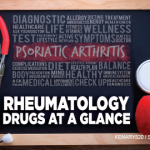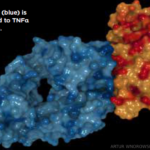Etanercept (Enbrel):15 injection
Drug class: DMARD, TNFi
Boxed warning: Refer to *ISI (left)
Warnings & Precautions
- Do not start etanercept during an active infection. If an infection develops, monitor carefully, and stop etanercept if the infection becomes serious.
- Consider empiric anti-fungal therapy for patients at risk (those who reside in or travel to regions where mycoses are endemic) for invasive fungal infections who develop a severe systemic illness on etanercept.
- Demyelinating disease, exacerbation or new onset, may occur.
- Cases of lymphoma have been observed in patients receiving TNFi’s.
- Congestive heart failure, worsening or new onset, may occur.
- Advise patients to seek immediate medical attention if symptoms of pancytopenia or aplastic anemia develop, and consider stopping etanercept.
- Monitor HBV carriers for reactivation during and following therapy. If reactivation occurs, consider stopping etanercept and beginning anti-viral therapy.
- Anaphylaxis or serious allergic reactions may occur.
- Stop etanercept if lupus-like syndrome or autoimmune hepatitis develops.
Dosage & Administration
Etanercept is administered by subcutaneous injection.
Adults: The starting dose is 50 mg twice weekly for three months. The maintenance dose is 50 mg once weekly.
Pediatrics:
- 63 kg (138 lbs.) or more: the recommended dose is 50 mg weekly.
- Less than 63 kg (138 lbs.): the recommended dose is 0.8 mg/kg weekly.
Commentary: Etanercept is approved for adult and pediatric plaque psoriasis. It is the first and only systemic therapy to treat children aged 4-17 years for chronic moderate to severe plaque psoriasis. The most common adverse reactions (≥5%) are infections and injection-site reactions.
Infliximab (Remicade):16 infusion
Biosimilar(s): Infliximab-dyyb (Inflectra),17 Infliximab-abda (Renflexis),18 Infliximab-qbtx (Ixifi)19
Drug class: DMARD, TNFi
Boxed warning: Refer to *ISI (above) and
- Fatal hepatosplenic T-cell lymphoma (HSTCL) have been reported in patients treated with TNFi’s, postmarketing. All infliximab cases occurred in IBD patients, who were mostly adolescent or young adult males. All had received azathioprine or 6-mercaptopurine concomitantly with infliximab at or prior to diagnosis.
Warnings & Precautions
- Do not give infliximab during an active infection. If an infection develops, monitor carefully and stop infliximab if the infection becomes serious.
- Invasive fungal infections—for patients who develop a systemic illness on infliximab, consider empiric anti-fungal therapy for those who reside or travel to regions where mycoses are endemic
- The incidence of malignancies, including lymphoma, was greater in infliximab-treated patients than in controls. Due to the risk of HSTCL, carefully assess the risk/benefit especially in IBD patients, in males, and if receiving azathioprine or 6-mercaptopurine treatment.
- HBV reactivation can occur. Test for HBV infection before starting infliximab. Monitor HBV carriers during and several months after therapy. If reactivation occurs, stop infliximab and begin anti-viral therapy.
- Hepatotoxicity—rare severe hepatic reactions, some fatal or necessitating liver transplantation have occurred. Stop infliximab in cases of jaundice and/or marked liver enzyme elevations.
- Heart failure, new onset or worsening symptoms, may occur.
- Cytopenias—advise patients to seek immediate medical attention if signs and symptoms develop, and consider stopping infliximab.
- Hypersensitivity—serious infusion reactions including anaphylaxis or serum sickness-like reactions may occur.
- Demyelinating disease, exacerbation or new onset, may occur.
- Lupus-like syndrome—stop infliximab if syndrome develops.
- Live vaccines or therapeutic infectious agents should not be given with infliximab.
Dosage & Administration
Infliximab is administered by intravenous infusion over a period of not less than two hours. The recommended dose is 5 mg/kg given as an intravenous induction regimen at 0, 2 and 6 weeks, followed by a maintenance regimen of 5 mg/kg every eight weeks.
Commentary: The FDA approved infliximab for treatment of psoriasis based on data from two multicenter clinical trials that enrolled 1,200 patients. The results showed that a majority of infliximab-treated patients achieved clinically significant levels of skin clearance with induction and every-eight-week maintenance therapy. The most common adverse reactions (≥10%) are infections (e.g., upper respiratory, sinusitis, pharyngitis), infusion-related reactions, headache and abdominal pain.



